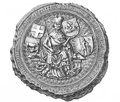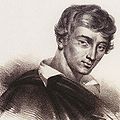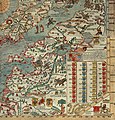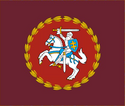Portal:Lithuania
Welcome to the Lithuania Portal — Sveiki atvykę į Lietuvos Portalą
Lithuania (/ˌlɪθjuˈeɪniə/ ⓘ LITH-yoo-AYN-ee-ə; Lithuanian: Lietuva [lʲɪɛtʊˈvɐ]), officially the Republic of Lithuania (Lithuanian: Lietuvos Respublika [lʲɪɛtʊˈvoːs rʲɛsˈpʊblʲɪkɐ]), is a country in the Baltic region of Europe. It is one of three Baltic states and lies on the eastern shore of the Baltic Sea. It borders Latvia to the north, Belarus to the east and south, Poland to the south, and Russia to the southwest, with a maritime border with Sweden to the west. Lithuania covers an area of 65,300 km2 (25,200 sq mi), with a population of 2.86 million. Its capital and largest city is Vilnius; other major cities are Kaunas, Klaipėda, Šiauliai and Panevėžys. Lithuanians belong to the ethnolinguistic group of the Balts and speak Lithuanian, one of only a few living members of the Baltic branch of the Indo-European language family, which is also the most widely spoken language of the branch.
For millennia, the southeastern shores of the Baltic Sea were inhabited by various Baltic tribes. In the 1230s, Lithuanian lands were united for the first time by Mindaugas, who formed the Kingdom of Lithuania on 6 July 1253. Subsequent expansion and consolidation resulted in the Grand Duchy of Lithuania, which by the 14th century was the largest country in Europe. In 1386, the Grand Duchy entered into a de facto personal union with the Crown of the Kingdom of Poland. The two realms were united into the bi-confederal Polish-Lithuanian Commonwealth in 1569, forming one of the largest and most prosperous states in Europe. The Commonwealth lasted more than two centuries, until neighbouring countries gradually dismantled it between 1772 and 1795, with the Russian Empire annexing most of Lithuania's territory. Towards the end of World War I, Lithuania declared Independence in 1918, founding the modern Republic of Lithuania. In World War II, Lithuania was occupied by the Soviet Union, then by Nazi Germany, before being reoccupied by the Soviets in 1944. Lithuanian armed resistance to the Soviet occupation lasted until the early 1950s. On 11 March 1990, a year before the formal dissolution of the Soviet Union, Lithuania became the first Soviet republic to break away when it proclaimed the restoration of its independence.
Lithuania is a developed country with a high income, advanced economy, ranking 35th in the Human Development Index. Lithuania is a member of the European Union, the Council of Europe, the eurozone, the Nordic Investment Bank, the Schengen Agreement, NATO, and OECD. It also participates in the Nordic-Baltic Eight (NB8) regional co-operation format. (Full article...)
Selected article -
The Sejny Uprising or Seinai Revolt (Polish: Powstanie sejneńskie, Lithuanian: Seinų sukilimas) refers to a Polish uprising against the Lithuanian authorities in August 1919 in the ethnically mixed area surrounding the town of Sejny (Lithuanian: Seinai). When German forces, which occupied the territory during World War I, retreated from the area in May 1919, they turned over administration to the Lithuanians. Trying to prevent an armed conflict between Poland and Lithuania, the Entente drew a demarcation line, known as the Foch Line. The line assigned much of the disputed Suwałki (Suvalkai) Region to Poland and required the Lithuanian Army to retreat. While the Lithuanians retreated from some areas, they refused to leave Sejny (Seinai), because of its major Lithuanian population. Polish irregular forces began the uprising on August 23, 1919, and soon received support from the regular Polish Army. After several military skirmishes, Polish forces secured Sejny and the Lithuanians retreated behind the Foch Line.
The uprising did not solve the larger border conflict between Poland and Lithuania over the ethnically mixed Suwałki Region. Both sides complained about each other's repressive measures. The conflict intensified in 1920, causing military skirmishes of the Polish–Lithuanian War. Sejny changed hands frequently until the Suwałki Agreement of October 1920, which left Sejny on the Polish side. The uprising undermined the plans of Polish leader Józef Piłsudski who was planning a coup d'état in Lithuania to replace the Lithuanian government with a pro-Polish cabinet which would agree to a union with Poland (the proposed Międzymorze federation). Because the Sejny Uprising had prompted the Lithuanian intelligence to intensify its investigations of Polish activities in Lithuania, they discovered plans for the coup and prevented it, arresting Polish sympathizers. These hostilities in Sejny further strained the Polish–Lithuanian relations. (Full article...)General images
Did you know -

- ...Jurgis Mačiūnas was a founding member and the central coordinator of Fluxus, an international community of artists, architects, composers, and designers?

Romualdas Marcinkus - ...football champion Romualdas Marcinkus (pictured) was the only Lithuanian pilot to serve in the Royal Air Force during the Second World War?
- ...the evil serial killer Hannibal Lecter from The Silence of the Lambs was born in Lithuania?
- ... that during the inaugurations of Lithuanian monarchs, Gediminas' Cap (depicted) was placed on the monarch's head by the bishop of Vilnius?
- ... that the Communist Party of Lithuania and Belorussia organized partisan units behind the front lines during the Polish–Soviet War?
- ... that the Church of St. Jacob, which had been used for centuries by Prussian Lithuanians in Klaipėda, was demolished by soldiers of the Soviet Armed Forces using tanks in 1959?
Selected images
Topics
Military of Lithuania
| ||||||||||||||
|---|---|---|---|---|---|---|---|---|---|---|---|---|---|---|
|
| Public holidays in Lithuania | |||
|---|---|---|---|
| Date | English name | Local name | Remarks |
| 1 January | New Year's Day | Naujųjų metų diena | |
| 16 February | Day of Restoration of the State of Lithuania (1918) | Lietuvos valstybės atkūrimo diena | |
| 11 March | Day of Restoration of Independence of Lithuania (1990) | Lietuvos nepriklausomybės atkūrimo diena | |
| Moveable Sunday | Easter Sunday | Šv. Velykos | Commemorates resurrection of Jesus. The first Sunday after the full moon that occurs on or soonest after 21 March. |
| The day after Easter Sunday | Easter Monday | Antroji šv. Velykų diena | |
| 1 May | International Workers' Day | Tarptautinė darbo diena | |
| First Sunday in May | Mother's Day | Motinos diena | |
| First Sunday in June | Father's Day | Tėvo diena | |
| 24 June | St. John's Day / Day of Dew | Joninės / Rasos | Celebrated according to mostly pagan traditions (Midsummer Day, Saint Jonas Day). |
| 6 July | Statehood Day | Valstybės (Lietuvos karaliaus Mindaugo karūnavimo) ir Tautiškos giesmės diena | Celebrates the 1253 coronation of Mindaugas, the first King of Lithuania, and the national anthem of Lithuania. |
| 15 August | Assumption Day | Žolinė (Švč. Mergelės Marijos ėmimo į dangų diena) | Also marked according to pagan traditions, celebrating the goddess Žemyna and noting the mid-August as the middle between summer and autumn. |
| 1 November | All Saints' Day | Visų šventųjų diena | Halloween is increasingly popular and is also informally celebrated on the eve (31 October). |
| 2 November | All Souls' Day | Mirusiųjų atminimo (Vėlinių) diena | |
| 24 December | Christmas Eve | Šv. Kūčios | |
| 25 and 26 December | Christmas Day | Šv. Kalėdos | Commemorates birth of Jesus. |
Categories
Recognized content
New articles
Rules | Match log | Results page (for watching) | Last updated: 2024-04-27 20:48 (UTC)
Note: The list display can now be customized by each user. See List display personalization for details.
- Embassy of India, Warsaw (edit | talk | history | links | watch | logs | tools) by Damiankramek (talk · contribs · new pages (1)) started on 2024-04-27, score: 60
- 2013 World Rowing Junior Championships (edit | talk | history | links | watch | logs | tools) by Rowing007 (talk · contribs · new pages (16)) started on 2024-04-26, score: 30
- Timeline of the Russian invasion of Ukraine (1 April 2024 – present) (edit | talk | history | links | watch | logs | tools) by Primium (talk · contribs · new pages (13)) started on 2024-04-26, score: 30
- St. Onuphrius Monastery in Jabłeczna (edit | talk | history | links | watch | logs | tools) by Oliwiasocz (talk · contribs · new pages (22)) started on 2024-04-26, score: 40
- Battle of Lipniszki (edit | talk | history | links | watch | logs | tools) by Joe Roe (talk · contribs · new pages (5)) started on 2024-04-26, score: 40
- Tamar Malca (edit | talk | history | links | watch | logs | tools) by CLalgo (talk · contribs · new pages (9)) started on 2024-04-26, score: 20
- Stacy Hollowell (edit | talk | history | links | watch | logs | tools) by BeanieFan11 (talk · contribs · new pages (43)) started on 2024-04-25, score: 30
- Laurentius Boierus (edit | talk | history | links | watch | logs | tools) by KrivisKrivaitis (talk · contribs · new pages (4)) started on 2024-04-25, score: 70
- Oleksandr Dermanskyi (edit | talk | history | links | watch | logs | tools) by Klavz (talk · contribs · new pages (2)) started on 2024-04-25, score: 30
- List of translations of The Lord of the Rings (edit | talk | history | links | watch | logs | tools) by Chiswick Chap (talk · contribs · new pages (5)) started on 2024-04-24, score: 30
- David Radzynski (edit | talk | history | links | watch | logs | tools) by HistoryTheorist (talk · contribs · new pages (3)) started on 2024-04-24, score: 30
- Chroniclers of Volyn and Ukraine (edit | talk | history | links | watch | logs | tools) by Nederlandse Leeuw (talk · contribs · new pages (19)) started on 2024-04-23, score: 20
- MIA. (German band) (edit | talk | history | links | watch | logs | tools) by Raydann (talk · contribs · new pages (61)) started on 2024-04-23, score: 20
- February 1978 (edit | talk | history | links | watch | logs | tools) by Mandsford (talk · contribs · new pages (2)) started on 2024-04-23, score: 20
- Skirgaila (play) (edit | talk | history | links | watch | logs | tools) by KrivisKrivaitis (talk · contribs · new pages (4)) started on 2024-04-23, score: 80
- Matti Milius (edit | talk | history | links | watch | logs | tools) by Doremo (talk · contribs · new pages (6)) started on 2024-04-20, score: 40
- List of Polish military aircraft (edit | talk | history | links | watch | logs | tools) by Fabrice Ram (talk · contribs · new pages (1)) started on 2024-04-23, score: 30
- 1992 Acropolis International Basketball Tournament (edit | talk | history | links | watch | logs | tools) by Dddenilson (talk · contribs · new pages (6)) started on 2024-04-23, score: 60
- Borisas Dauguvietis (edit | talk | history | links | watch | logs | tools) by KrivisKrivaitis (talk · contribs · new pages (4)) started on 2024-04-22, score: 90
- Battle of Nowa Woda (edit | talk | history | links | watch | logs | tools) by Wladekimperialny (talk · contribs · new pages (3)) started on 2024-04-22, score: 30
- 1999–2000 FC Dinamo București season (edit | talk | history | links | watch | logs | tools) by Mario Silvas (talk · contribs · new pages (4)) started on 2024-04-21, score: 30
- 2002–03 in Swiss football (edit | talk | history | links | watch | logs | tools) by Huligan0 (talk · contribs · new pages (5)) started on 2024-04-20, score: 30
- 2003–04 in Swiss football (edit | talk | history | links | watch | logs | tools) by Huligan0 (talk · contribs · new pages (5)) started on 2024-04-20, score: 30
- Valerija Narvydaitė (edit | talk | history | links | watch | logs | tools) by Soman (talk · contribs · new pages (27)) started on 2024-04-20, score: 110
- Antoni Matuszkiewicz (edit | talk | history | links | watch | logs | tools) by Oliwiasocz (talk · contribs · new pages (22)) started on 2024-04-19, score: 30
- European Union–Turkey relations (edit | talk | history | links | watch | logs | tools) by Mrjurism (talk · contribs · new pages (1)) started on 2024-04-18, score: 40
- Pabradė Training Area (edit | talk | history | links | watch | logs | tools) by Mindaur (talk · contribs · new pages (2)) started on 2024-04-18, score: 60
- Second Brusilov offensive (edit | talk | history | links | watch | logs | tools) by Vaclaw1990 (talk · contribs · new pages (1)) started on 2024-04-18, score: 40
- Lonka Korzybrodska (edit | talk | history | links | watch | logs | tools) by Mikenorton (talk · contribs · new pages (2)) started on 2024-04-17, score: 40
- The Yad Vashem Encyclopedia of the Ghettos During the Holocaust (edit | talk | history | links | watch | logs | tools) by Rafi Chazon (talk · contribs · new pages (6)) started on 2024-04-16, score: 20
- Juozas Tallat-Kelpša (edit | talk | history | links | watch | logs | tools) by In ictu oculi (talk · contribs · new pages (1)) started on 2024-04-16, score: 40
- Laurynas Kasčiūnas (edit | talk | history | links | watch | logs | tools) by Augenis (talk · contribs · new pages (1)) started on 2024-04-16, score: 90
- Heimattreue Front (edit | talk | history | links | watch | logs | tools) by Minorities observer (talk · contribs · new pages (1)) started on 2024-04-16, score: 20
- AviaAM (edit | talk | history | links | watch | logs | tools) by No way electricity is not a magic (talk · contribs · new pages (3)) started on 2024-04-16, score: 80
- Bela Yaari Hazan (edit | talk | history | links | watch | logs | tools) by Mikenorton (talk · contribs · new pages (2)) started on 2024-04-15, score: 50
- Gonaičiai (edit | talk | history | links | watch | logs | tools) by Liggeue Bequi (talk · contribs · new pages (1)) started on 2024-04-15, score: 60
- List of Euro coin series (edit | talk | history | links | watch | logs | tools) by Antony-22 (talk · contribs · new pages (1)) started on 2024-04-15, score: 30
- Akmena Lacus (edit | talk | history | links | watch | logs | tools) by Bennett1203 (talk · contribs · new pages (9)) started on 2024-04-14, score: 60
- Moses ben Abraham (edit | talk | history | links | watch | logs | tools) by Srnec (talk · contribs · new pages (71)) started on 2024-04-14, score: 20
- Vitaly Goryaev (edit | talk | history | links | watch | logs | tools) by Valeino (talk · contribs · new pages (5)) started on 2024-04-14, score: 40
- Vilniaus HC Amber (edit | talk | history | links | watch | logs | tools) by Fakez76 (talk · contribs · new pages (1)) started on 2024-04-14, score: 90
- Patricija Paukštytė (edit | talk | history | links | watch | logs | tools) by Vecihi91 (talk · contribs · new pages (5)) started on 2024-04-14, score: 100
- Klaudija Bubelytė (edit | talk | history | links | watch | logs | tools) by Vecihi91 (talk · contribs · new pages (5)) started on 2024-04-14, score: 80
- Algis Jurgis Kundrotas (edit | talk | history | links | watch | logs | tools) by Mojmir Churavy (talk · contribs · new pages (1)) started on 2024-04-14, score: 60
- Camp Herkus (edit | talk | history | links | watch | logs | tools) by CormacGallagher (talk · contribs · new pages (3)) started on 2024-04-13, score: 60
- Yury Olelkovich-Slutsky (edit | talk | history | links | watch | logs | tools) by Mellk (talk · contribs · new pages (21)) started on 2024-04-12, score: 50
Associated Wikimedia
The following Wikimedia Foundation sister projects provide more on this subject:
-
Commons
Free media repository -
Wikibooks
Free textbooks and manuals -
Wikidata
Free knowledge base -
Wikinews
Free-content news -
Wikiquote
Collection of quotations -
Wikisource
Free-content library -
Wikiversity
Free learning tools -
Wikivoyage
Free travel guide -
Wiktionary
Dictionary and thesaurus
























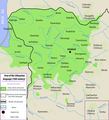











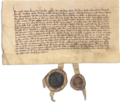






















![Image 61The preservation of the Great Seal of Lithuania (pictured, dating to 1623) when concluding the Union of Lublin meant that the elected monarchs acts without being confirmed with the Lithuanian seals were void in Lithuania. These Lithuanian seals were in possession of the Lithuanian Grand Chancellor (Great Seal) and Lithuanian Vice-Chancellor [lt] (Lesser Seal). (from Grand Duchy of Lithuania)](http://upload.wikimedia.org/wikipedia/commons/thumb/e/ec/The_Great_Seal_of_Lithuania_%28with_Vytis%29_from_the_reign_of_Sigismund_III_Vasa%2C_1623.png/120px-The_Great_Seal_of_Lithuania_%28with_Vytis%29_from_the_reign_of_Sigismund_III_Vasa%2C_1623.png)

























